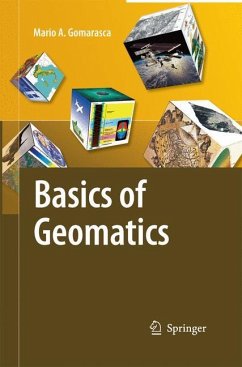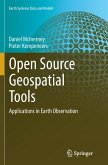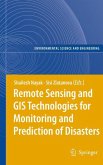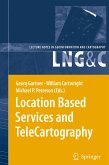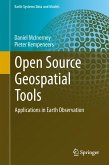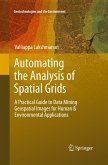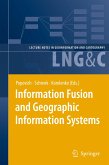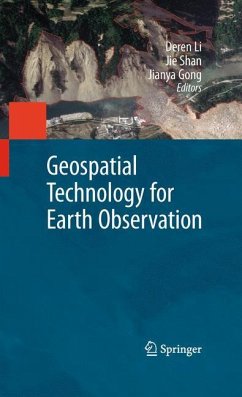Geomatics is a neologism, the use of which is becoming increasingly widespread, even if it is not still universally accepted. It includes several disciplines and te- niques for the study of the Earth's surface and its environments, and computer science plays a decisive role. A more meaningful and appropriate expression is G- spatial Information or GeoInformation. Geo-spatial Information embeds topography in its more modern forms (measurements with electronic instrumentation, sophisticated techniques of data analysis and network compensation, global satellite positioning techniques, laser scanning, etc.), analytical and digital photogrammetry, satellite and airborne remote sensing, numerical cartography, geographical information systems, decision support systems, WebGIS, etc. These specialized elds are intimately interrelated in terms of both the basic science and the results pursued: rigid separation does not allow us to discover several common aspects and the fundamental importance assumed in a search for solutions in the complex survey context. The objective pursued by Mario A. Gomarasca, one that is only apparently modest, is to publish an integrated text on the surveying theme, containing simple and comprehensible concepts relevant to experts in Geo-spatial Information and/or speci cally in one of the disciplines that compose it. At the same time, the book is rigorous and synthetic, describing with precision the main instruments and methods connected to the multiple techniques available today.
From the reviews:
"The book is rigorous and synthetic, describing with precision the main instruments and methods connected to the multiple techniques today available. The objective pursued is to publish an integrated text, containing simple and comprehensible concepts relevant to experts in Geo-spatial Information." -- S. Dequal, Professor of Topography and Photogrammetry, DITAG, Polytechnic of Turin, Italy
"This book fills a void of telling and showing the reader how remote sensing as a part of geomatics really works. With a clearly presented historical review up to the present time, the author illustrates the basic theories and use of the different remote sensing sensors and how to analyze the data from them for their application. The author has had many years of experience in the analysis of remote sensing data and one can feel the confidence that he has as in presenting the material. This book would be a complement to the standard remote sensing books and I would highly recommend it for all land oriented professionals and especially graduate students who need a clear explanation of how remote sensing works. For anyone who uses remote sensing data as related to land analysis and survey, this book should be part of their library." -- Chris J. Johannsen, Professor Emeritus of Agronomy, Department of Agronomy
"Basics of Geomatics is structured in a clear and effective way into thematic chapters that provide a fundamental, yet comprehensive coverage of each of the major disciplines making up the field of Geomatics.
Thanks to its clarity and completeness, the text, supplemented by many useful tables and illustrations will serve as a basic reference work for both beginners and experienced readers." -- J.L.van Genderen, ITC, Enschede, The Netherlands
"This work, translated from Italian, is unique in that it addresses a particular gap in the remote sensing literature ... aimed at a broader group of readers who may be using geospatial information in their work. ... The text is supported with numerous illustrations and well-explicated formula. ... color plates are included at the end of the volume. The comprehensive index greatly contributes to this book's effectiveness as a reference tool for both students and professionals. Summing Up: Recommended. Upper-division undergraduate through professional collections." (W. Weston, Choice, Vol. 47 (11), August, 2010)
"The book is rigorous and synthetic, describing with precision the main instruments and methods connected to the multiple techniques today available. The objective pursued is to publish an integrated text, containing simple and comprehensible concepts relevant to experts in Geo-spatial Information." -- S. Dequal, Professor of Topography and Photogrammetry, DITAG, Polytechnic of Turin, Italy
"This book fills a void of telling and showing the reader how remote sensing as a part of geomatics really works. With a clearly presented historical review up to the present time, the author illustrates the basic theories and use of the different remote sensing sensors and how to analyze the data from them for their application. The author has had many years of experience in the analysis of remote sensing data and one can feel the confidence that he has as in presenting the material. This book would be a complement to the standard remote sensing books and I would highly recommend it for all land oriented professionals and especially graduate students who need a clear explanation of how remote sensing works. For anyone who uses remote sensing data as related to land analysis and survey, this book should be part of their library." -- Chris J. Johannsen, Professor Emeritus of Agronomy, Department of Agronomy
"Basics of Geomatics is structured in a clear and effective way into thematic chapters that provide a fundamental, yet comprehensive coverage of each of the major disciplines making up the field of Geomatics.
Thanks to its clarity and completeness, the text, supplemented by many useful tables and illustrations will serve as a basic reference work for both beginners and experienced readers." -- J.L.van Genderen, ITC, Enschede, The Netherlands
"This work, translated from Italian, is unique in that it addresses a particular gap in the remote sensing literature ... aimed at a broader group of readers who may be using geospatial information in their work. ... The text is supported with numerous illustrations and well-explicated formula. ... color plates are included at the end of the volume. The comprehensive index greatly contributes to this book's effectiveness as a reference tool for both students and professionals. Summing Up: Recommended. Upper-division undergraduate through professional collections." (W. Weston, Choice, Vol. 47 (11), August, 2010)

